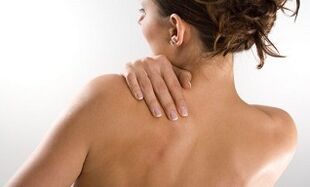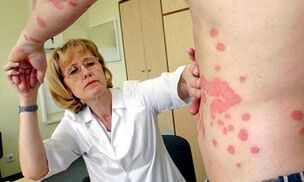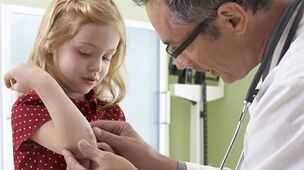
A chronic disease of a non-communicable nature that, according to statistical data, affects a few percent of the entire population, is psoriasis, symptoms manifest as a localized rashintense, itching and peeling of the skin.
The disease can develop at any age and does not depend on the social environment to which a person belongs. Psoriasis occurs equally in men and women. Most often, the disease affects young people under twenty.
Many people are interested in the question: "Is psoriasis itchy, what are the symptoms and treatments and most importantly, is it contagious? " Psoriasis is present in almost 85% of casesBut the disease is completely non-contagious and is not transmitted by airborne droplets or by household means. It is difficult to treat, but complex therapy almost always gives good results.
Disease manifestation
How is psoriasis manifest and what is it? Psoriatic plaques usually develop first in areas that are most frictional, such as elbows or knees.
In addition, the signs of psoriasis can appear on any area of skin - head, face, back, abdomen, palms, feet, armpits and even genitals.
If we consider another similar disease - eczema, then it affects the inner part of the folding muscle surface, with psoriasis - the outer part of the knee and elbow joints.
Pathology is chronic and undulating, meaning a person's condition may improve under the influence of treatments or, vice versa, worsen under the influence of factors. remission and exacerbation were often completely spontaneous.
Relapse can be caused by alcohol abuse, stress, and infectious diseases. The severity of psoriasis varies from person to person, and even from the same person, over the course of the illness.

The main symptoms of psoriasis skin are plaques, which appear as small lesions in certain areas. In some cases, they can cover the entire body.
Psoriasis progresses over time, especially if no proper measures are taken to correct it. The progression of the disease includes an increase in exacerbations and an increase in the area of the lesion with the participation of healthy areas in the inflammatory process. There are cases where the disease progresses continuously without any time of remission.
Pathologies like nail dystrophy - nail damage is very common. The disease can progress on its own without accompanying skin damage. In addition, psoriasis can contribute to the development of inflammatory processes in the joints - psoriatic arthritis (a disease of the small joints of the lower extremities and hands), and nail dystrophy is observed inabout 15% of patients suffer from psoriasis.
There are many different ways to deal with this disease, but since it tends to recur consistently and gets worse, psoriasis is difficult to treat. A complete cure is almost impossible, i. e. it will stay with one person for the rest of life, but if treated properly and followed all prescriptions, long remission times can be achieved. than.
Reason
So far, medicine has not yet known the true cause of this pathology, however, it has been shown that malfunctions of the immune system, neurological and metabolic disorders havecan cause disease. There are also a number of factors that can trigger the development of the disease:
- Genetic predisposition,in other words simple genetics. Experts say, identifying signs of psoriasis can be found in people related to the bloodstream with psoriasis. Furthermore, if either parent becomes ill, the risk of developing the disease increases by 20%, and if both parents - up to 50%. This is due to the existence of certain genes responsible for the development of dermatological changes. The first signs of hereditary psoriasis appear before age 25.
- Neurological disorders.Any emotional shock, nervous tension, or chronic fatigue can cause the development of the disease. Also, in people with psoriasis, any stressful situation can aggravate the disease.
- Hormonal insufficiency.All pathological changes in the functioning of the organs of the endocrine system may trigger the mechanism of development of the disease.
- Violation of metabolic processes.Metabolic disorders associated with a lack of beneficial trace elements and vitamins in the body can cause psoriasis.
- Invasion of germs.Certain types of parasites can cause disease. Many laboratory studies have been done, the results show that many patients with psoriasis were infected with giardia, opisthorchiasis, ascariasis, enterobiasis. The thing is, during its vital activity, the helminth will release a toxic substance that poisoning the entire body. This leads to an increase in chronic diseases and a significant decrease in immunity.
- Viral infections,also attack the human immune system.
From the above, it is clear that the development of psoriasis is, in one way or another, involved in the disturbance of the work of the body's protective mechanisms. Psoriasis on the body can develop under a range of triggers, or under factors such as unbalanced diet, climate change, alcohol abuse and smoking. .
Clinical images and types of psoriasis
How Does Psoriasis Start? The first symptoms of the disease are red patches and itchy and lichen-like scaly patches. Over time, these spots flake off and a denser layer of scales is found underneath them.
As the disease progresses, Kenber phenomenon is observed, when plaques appear in areas of traumatic skin injuries (wounds, cuts, burns).
Types
There are several types of psoriasis, each with a specific clinical image:
- Plaque (real psoriasis)is the most common form of the disease, occurring in more than 80% of patients. The skin is inflamed, dry and thickened, with areas raised above it, covered with pale silvery scales. The skin in these areas is hot to the touch and constantly flakes. After flaking, red inflammatory foci are found, often damaged and bleeding. Inflammation can merge into large foci. With psoriasis in the elbows and knees, the flaking is not so pronounced.
- Droplet- there are many small, red or purple, circular dry pimples that protrude from the surface of the skin. Bowel psoriasis covers large areas of the body. The first signs of the disease may appear after a previous episode of sore throat or pharyngitis, caused by streptococcal infection.
- Pustulesare the most difficult to treat. It has the appearance of blistering rashes that protrude on the surface of healthy skin. These bubbles are filled with secretions. Around the pustules, the skin turns red, swollen, thickens and then flakes off. When there is a secondary infection, the blisters are filled with pus. Usually, this psoriasis is limited and affects specific areas, such as the lower legs and forearms. In severe cases, the inflammation begins to spread further along the skin's surface and the rash fuses into one spot.
- Psoriatic arthritis- joints and connective tissue involved in the pathological process. The main manifestation of this form is intense itching. In addition, the skin of the knuckles becomes sore, swollen, and flaky.
- Nail dystrophy (nail psoriasis)can be like a fungal skin disease. With such a disease, the appearance of nails changes, they become brittle and flaky, the color of the nail layer and itself may turn yellow or gray. In addition, white spots, dots and horizontal lines appear on the nail and under the fingernail. The skin under and around the nail becomes firm. Very often, nail dystrophy leads to the loss of the fingernail.
Other psoriasis symptoms include:
- bleeding wounds (in areas of skin trauma);
- nail erosion;
- severe itching;
- fever, swelling, and joint pain in psoriatic arthritis (not always).
How the disease progressed
The course of the disease has several stages:
- Progress.This is the early stage of the disease. It is characterized by exacerbations, in which there is an increase in the number of new rashes.
- Stationery.At this stage, the picture of the disease remains unchanged, that is, the rash and other symptoms of psoriasis do not increase or decrease.
- Regression phase.Late stage of the disease, no rash.
Depending on the prevalence of the inflammatory process, the disease can be:
- restrictive- small areas of skin are affected;
- general- large areas of skin are affected;
- general- almost the entire surface of the body is affected.
Among other things, psoriasis is considered a seasonal disease, ie, all symptoms worsen depending on the season. Most people get worse in winter or summer. In some patients this process is not related to a change in season.
Diagnosis

How was this disease diagnosed? The diagnosis of psoriasis is mainly based on examination by a dermatologist. Examination allows you to determine the shape and extent of the lesion.
In some cases, a differential diagnosis is made to distinguish psoriasis from another dermatological disease. How do I know if a patient has this particular disease?
As mentioned, in psoriasis, the Kenber phenomenon is observed, which is not present in the skin pathology. Another symptom to watch out for is a bright ring around a new papule that has not yet begun to peel off - a type of vascular reaction, indicating further progression of the disease.
Sometimes a skin biopsy is used to make a more accurate diagnosis or to perform tests that can detect the inflammatory process in the blood. After psoriasis is diagnosed, you need to start treatment immediately.
Treatment
Medicines
The main therapy is the use of topical preparations in the form of ointments, gels, creams and sprays.
These medications contain ingredients that prevent excess cell division on the skin and relieve the symptoms of itchiness and irritation. There are several substances that are effective against this disease:
- Glucocorticoid hormone.They reduce inflammation and normalize the immune system.
- Vitamin D.The use of drugs with vitamin D is most effective after the disease turns to a stationary phase, when the patient's condition is stable. Good results are obtained when using these drugs in combination with UV radiation procedures.
- Silicon.Improves the condition of the skin, has the effect of burning and absorbing antigens that are involved in the development of the disease.
- Tarhas a good effect on focal inflammatory foci of the head.
- Lecithin.Promotes rapid tissue regeneration. Preparations with these substances help the body cope with inflammation more quickly.
- Activated zincbriefly removes redness and reduces itching.
Patients are also prescribed drugs of the following groups:
- corticosteroid- normalizes metabolic processes;
- cytostatic- suppresses cell division, but may impair the body's defense mechanisms;
- immunomodulators- also modulate immune responses, but their effectiveness is still being discussed;
- non-steroidal- reduces inflammation and itching.
Vitamin complexes are prescribed in combination with these drugs.
Along with drug treatments, the following methods are very popular:
- Heirloom therapy.Leech therapy improves blood circulation and normalizes immune mechanisms.
- Cryotherapy.A special "freezing" way to reduce itching, swelling and inflammation.
- Ultraviolet projection.These short-term procedures are associated with the introduction of special drugs.
Attention!It is unacceptable to buy self-medication for psoriasis, since many drugs have contraindications and are prescribed by a specialist taking into account only the individual physiological characteristics of the patient.

Children often have less severe episodes of psoriasis than adults, so topical therapy gives good results, and even in the case of exacerbations, a repeat course of treatment can be displaced. long term reduction.
Even if a child is diagnosed with a severe form, if the child is properly treated, the prognosis will be more or less favorable.
The main rule for parents is to know how to recognize the characteristic signs of psoriasis and get started in fighting the disease!
Traditional medicine
Traditional medicine formulas are commonly used to treat psoriasis. Medicinal-based tablets will be effective.
For compression, crush 4 tablespoons. spoon the dried herbs and pour one cup of boiling water, then let it brew. In the broth, you need to moisten the gauze and place it on the sore.
The following plants have medicinal properties:
- calendula;
- ponytail;
- walnut leaves;
- royal tree;
- grass competition;
- sweet clover;
- burdock;
- black currant leaves.
You can also prepare oral tincture. For this, 1 tbsp. Pour 1 teaspoon of dried herbs with one cup of boiling water, steep for 8 hours, filter 100 ml twice a day, preferably half an hour before meals. Suitable for herbal collections:
- St. John's wort;
- royal tree; sequence
- ;
- marshmallows;
- valerian.
Attention!Some of these herbs can cause side effects, so before starting treatment you must be familiar with all the contraindications.

Home treatment ointments are very popular. Here are some effective formulas:
- Burn dried rose hips and mix the ash with kerosene. Ointment should be applied to the affected areas every day.
- Grind the leaves of the royal tree to make 2 tablespoons. spoon, add lanolin and kerosene. Ointment for the treatment of inflamed skin.
- Mix the tincture of mass with lanolin and kerosene and rub on the psoriatic patches.
- Grind the grass roots, mix with oil or kerosene, boil the resulting ointment, let it cool and apply to the sore spots.
Soothing herbal teas are very beneficial. They can be brewed from chives, oregano, chamomile, mint, thyme, valerian, linden, peony.
Traditional medicine does not guarantee 100% results, it is best to combine it with the main treatment.
Psoriasis and pregnancy
Many women with psoriasis worry about how the disease will progress during this period.
Psoriasis is an unpredictable disease, so it is difficult to answer the question: "How do I determine the course of the disease during pregnancy". Symptoms of psoriasis may begin to progress, stand still or decrease. In some cases, after giving birth, the disease disappeared completely.
Every pregnant woman is concerned that the disease could be transmitted to her baby, but the disease itself is not hereditary, but only an underlying factor.

During a breastfeeding period, if the mother is on strong drug treatment, it will be dangerous to breastfeed because these substances can harm the health of the baby. In this case, you need to interrupt treatment or transfer the child to artificial feeding.
This disease does not affect pregnancy and development in the uterus of the fetus, but the drugs taken by a pregnant mother can have negative consequences, so it is important toConsult with your doctor when planning a pregnancy, your doctor will cancel some of those drugs.
Precautions
This disease cannot be prevented, but its manifestations can be greatly reduced. To reduce the symptoms of the disease, you must adhere to the following rules of prevention:
- Try not to worry and learn to control your emotions. Natural sedatives can be used to ease this work.
- Reduce your consumption of salty, smoked, spicy, fried and fatty foods, as well as honey, citrus fruits, chocolate, and coffee.
- Wear clothing made of natural fabrics.
- Choose personal care products with a low pH so as not to dry out or irritate painful skin.
- Be careful with medications because many can cause psoriasis flare-ups, antibiotics are particularly dangerous.
- Quit smoking and alcohol.
- Avoid direct sunlight.
Psoriasis is one of the most common skin diseases, its nature is not well understood. This disease causes many inconveniences, reduces the quality of life and lowers the self-esteem of the patient.
It can happen suddenly and unfortunately, no one is immune to the disease. That is why it is very important to know how this pathology manifests so as to consult a doctor promptly and start treatment.

























